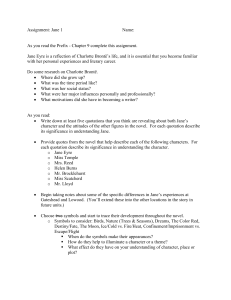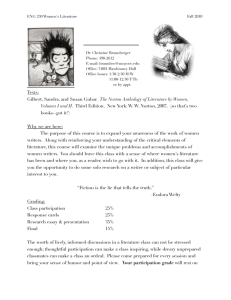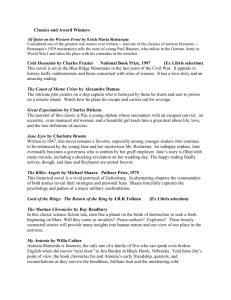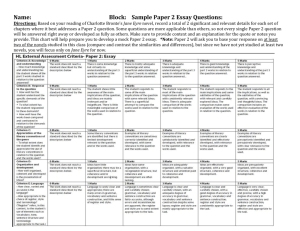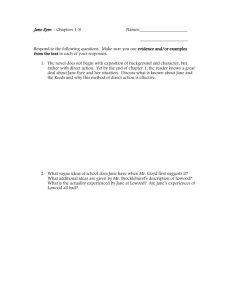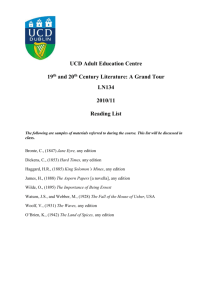Background Information for Jane Eyre
advertisement
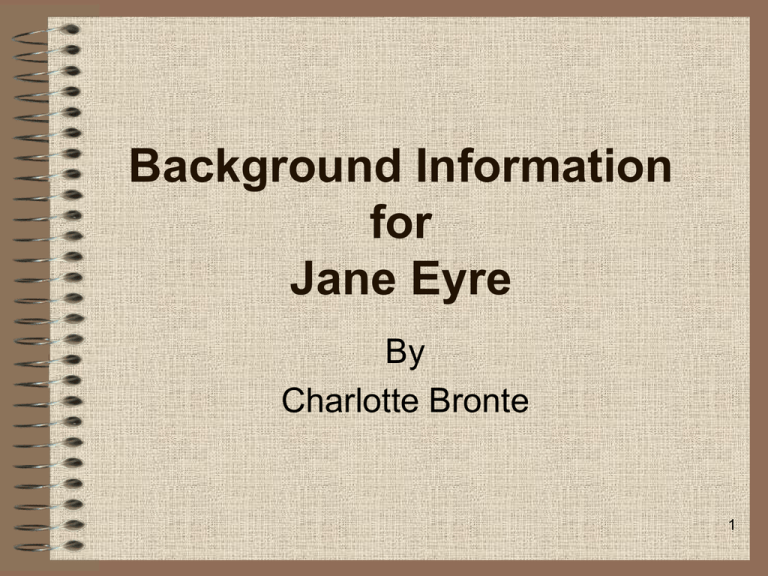
Background Information for Jane Eyre By Charlotte Bronte 1 THE NOVEL •Published in October 1847 •During the Industrial Revolution •A novel of the Victorian Age 2 Victorian England • Queen Victoria – reigned from 1837-1901 • Industrial Revolution – new urbanization caused overcrowding and insanitary conditions • Queen Victoria strove to improve conditions in urban slums and break the cycle of poverty • Limited rights for women: divorce, property, guardianship, etc. 3 Female Education • Became fashionable to educate women, but only the very wealthy could afford to send their daughters to elite schools • Less costly schools were formed by well-meaning benefactors to educate poor females. • Illness was common –no clear understanding of the relationship between dirt & disease • With the new stress on female education, governesses were in demand to educate young ladies in the home. • Pay was poor, but it was one of the only jobs available to educated, yet impoverished young women 4 Role of the governess • Employers & other servants shunned the governess because they felt she was “putting on airs.” • Her employers would ignore her, too, because she had a superior education, which intimidated many people. 5 Charlotte Bronte • Born of Irish ancestry in 1816 in Yorkshire, England •Lived at Haworth, a parsonage •Mother died of cancer when Charlotte was 5 years old. 6 The Bronte family • Charlotte had 4 sisters and 1 brother. • While at the Clergy Daughters’ School, her 2 older sisters (Maria & Elizabeth) contracted tuberculosis and died at home 7 Talented Family • Charlotte, Emily, and Anne became authors, publishing under male pen names: Currer, Ellis, and Acton Bell • Emily wrote Wuthering Heights and Anne wrote Agnes Grey • Charlotte’s brother, Branwell, was a gifted painter. 8 Marriage and Death • In 1854 She marries her father's curate, Arthur Bell Nichols, after failing to find “true love.” • The next year, she became pregnant, then ill. • She died a month before her 39th birthday – probably of tuberculosis 9 A ground breaking novel Why? 1. The heroine is small, plain, & poor 2. The heroine is the first female character to claim the right to feel strongly about her emotions and act on her convictions 3. This romantic ground had previously been reserved for males 4. Such a psychologically complex heroine had never been created before 10 Jane Eyre – many books in one • Autobiography • Fairy Tale • Bildungsroman/Quest • Marriage Plot • Gothic novel 11 Autobiography • Originally titled Jane Eyre: An Autobiography • Due to her upbringing, she often wrote about religious hypocrisy • The Clergy Daughters’ School became a model for Lowood Institution in the novel 12 More Autobiographical Details • Jane’s friend dies of tuberculosis contracted at school • Mr. Brocklehurst modeled on own reverend at school, Carus Wilson • Fate of John Reed, Jane’s cousin, closely parallels Branwell Bronte’s struggle with alcohol and heroin addictions • Bronte taught at a girls school and later became a governess – as Jane does in the 13 novel Fairy Tale Plot • Cinderella – Orphan girl with heart of gold abused by wicked stepmother and stepsisters gets her chance to meet a prince and prove her superiority 14 Alternate Fairy Tale • Beauty and the Beastyoung, innocent girl tames the dangerous beast and releases him from his life of misery 15 Bildungsroman • Also known as “coming of age” and “quest” stories • Deals with the growth and education of the protagonist • A journey to selfrealization and independence • Often includes the orphan archetype • Examples are: Great Expectations, The Adventures of Huckleberry Finn, A Separate Peace, Catcher in the Rye 16 Marriage Plot • 19th c. women’s fiction often sets aside the bildungsroman plot by either getting married or dying (DuPlessis) • 19th c. women’s fiction often shows that through marriage, women and men develop individually by merging gender roles • Ex: Emma, Little Women, Middlemarch, Pride and Prejudice 17 Gothic Elements • • • • • • • • • “Dark Romanticism” Mystery Haunted castle or house Dreaming and nightmares Doppleganger or alter ego Physical imprisonment Psychological entrapment Involvement of the supernatural “Distressed Heroine” – female protagonist pursued and persecuted by a villainous patriarchal figure in unknown landscape 18 Byronic Hero • This term is created by the famous poet George Gordon, Lord Byron. • Characteristics are… – Proud – Gloomy – Mysterious – Passionate *Mr. Rochester is an example of this type 19
